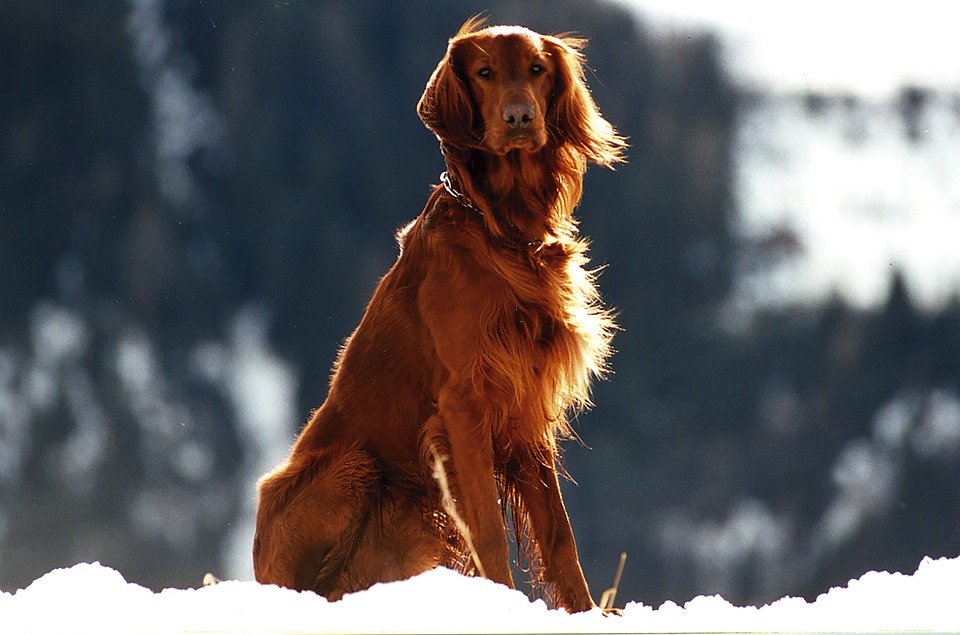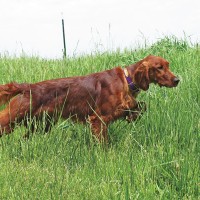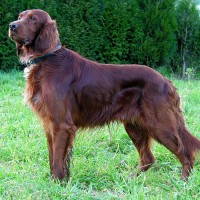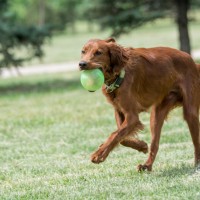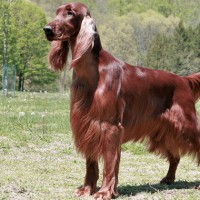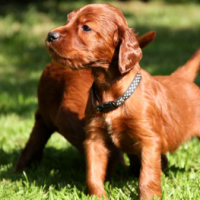Breed information
Group:
Sporting
Life span: 12-14 years
Height male: 66-71 cm / 26-28 inches
Height female: 61-66 cm / 24-26 inches
Weight male: 29-34 kg / 65-75 pounds
Weight female: 25-29 kg / 55-65 pounds
Character: Affectionate, Companionable, Energetic, Independent, Lively, Playful, Intelligent
History
One of the first references to the 'Setter,' or setting dog, in literature can be found in Caius's De Canibus Britannicus, which was published in 1570 (with a revised version published in 1576). It would be incorrect to assume the dog described above in any way resembles the Irish Setter (or any Setter) as we know the breed today. Caius was referring to a type of setting spaniel, most likely now extinct. The description of the work undertaken by this early pillar of the breed resembles the working behaviour of modern Irish Setters. Of this early dog, Caius went on to write: "The most part of theyre skinnes are white, and if they are marcked with any spottes, they are commonly red, and somewhat great therewithall." If this is the case, it is safe to assume the solid red colouring of today's Irish Setter came about by selective breeding practices.
Further reference to Setters in early literature can be found in The Country Farme by Surflet and Markham, published in 1616. They wrote: "There is also another sort of land spannyels which are called Setters."
It is clear that, by the early 18th Century, the type of dog known as the 'Setter' had come into its own right. It is also clear the Irish had begun actively breeding their own type. For example, the de Freyne family of French Park began keeping detailed stud records in 1793. Other prominent landed Irish gentry also known to have been breeding setter lines at the same time include Lord Clancarty, Lord Dillon, and the Marquis of Waterford.
It was noted as early as 1845 that Setters in Ireland were predominantly either red, or, according to Youatt, "...very red, or red and white, or lemon coloured, or white patched with deep chestnut." Clearly, the preference for a solidly-coloured dog was having an effect on the appearance of the typical Irish-bred setter.
The Breed Standard for the modern Irish Setter was first drawn up by the Irish Red Setter Club in Dublin and approved on 29 March 1886. It consisted of a 100-point scale, with a given number of points awarded for each of the dog's physical attributes. The points system was later dropped; however, aside from some minor changes, the Standard remains largely unchanged today in most countries where the breed is formally recognised.
Description
The Irish Setter is an active, aristocratic bird dog, rich red in color, substantial yet elegant in build. Standing over two feet tall at the shoulder, the dog has a straight, fine, glossy coat, longer on ears, chest, tail and back of legs. Afield, the Irish Setter is a swift-moving hunter; at home, a sweet natured, trainable companion.
Health
Irish Setters tend to be a relatively healthy breed. Problems that have been noted in Irish Setters include hip dysplasia, cancer, progressive retinal atrophy (PRA), epilepsy, entropion, hypothyroidism, hyperosteodystrophy, gastric dilatation volvulus (bloat), osteosarcoma, Von Willebrand's disease, patent ductus arteriosus, canine Leukocyte adhesion deficiency (CLAD) and celiac disease. Irish Setters are now one of the few breeds for which genetic tests have been developed to detect the presence of both CLAD and PRA (RCD-1). Gluten intolerance in Irish Setters is a naturally occurring genetic disorder that is the result of a single autosomal recessive locus. At around 6 months of age, Irish Setters with this condition will develop an increased immune cell presence and a decrease in absorption within the small intestine when fed a gluten containing diet. These affects lead to further damage of the small intestine as well as malnutrition and diarrhea. Irish Setters that are fed a gluten free diet have been shown to be exempt from any effects associated with gluten intolerance.
Personality
Irish Setters were developed to be bird dogs, tracking, pointing and retrieving game birds in the field. Today, they are rarely used in the field, but maintain their high energy and stamina in modern life. Irish Setters are loyal family dogs for those with active lifestyles. They get along well with children, love people and get along well with other household pets. They will want to be a part of any and every family activity. Though they are generally well-mannered dogs, Irish Setters are brimming with energy and are prone to leaping and jumping on guests. They are good watchdogs, in that they will let you know when someone is approaching, but they should not be relied upon as guard dogs – visitors will be welcomed into an Irish Setter's home as if they are old friends.
Activity Requirements
Irish Setters require a lot of activity to maintain an even temperament. Prospective owners should be prepared to dedicate at least one hour per day to a Setter's physical activity requirements. Brisk walks are good, but they should be allowed to run several times per week. Irish Setters are country dogs, they require wide open space and room to roam. Agility training is often a good outlet for Irish Setters as it works the mind and the body. Though they aren't as reliable as a Golden Retriever and may not win agility championships, Irish Setters enjoy the activity and appreciate the bonding time.
Trainability
Irish Setters need very little training when it comes to hunting birds, but household obedience is a different story. Don't let the long hair fool you – this is not a Golden Retriever. Training and Irish Setter requires patience, consistency and a calm-assertive attitude. This breed develops habits quickly, and bad habits can be nearly impossible to break, so the earlier you begin training a Setter, the better. Irish Setters can be rambunctious well after puppyhood passes and even if they receive adequate exercise. It is very important to teach your setter proper manners and not to jump on people, no matter how excited he may be to see them.
Best Training Equipment Trainers Recommend
Behavioral Traits
Separation Anxiety is common in this breed. Irish Setters are social creatures and they love spending time with people. Leaving them alone for long periods of time can lead to destructive behavior and excessive barking. It is important to properly exercise your Setter before leaving him alone, as lack of exercise can make these destructive tendencies worse. Irish Setters are best suited for people who have flexible work schedules, or families with a stay at home parent.
Shedding
The Irish Setter's coat needs to be brushed every other day to remove debris, loose hair and tangles; prevent mats, and keep the coat shiny and healthy. An Irish Setter who is brushed regularly only needs a bath a couple of times per year, unless the dog enjoys rolling around in the muck. The long, hanging ears do not allow air to circulate through the ear canal and makes the Irish Setter prone to ear infections. Check the ears weekly for redness, odor, or other signs of irritation or infection. Cleanse the ear with a cotton ball and a veterinarian-approved solution. Brush teeth weekly to remove tartar buildup, promote gum health and keep bad breath at bay. Trim nails monthly if the dog does not naturally wear them down outdoors.
